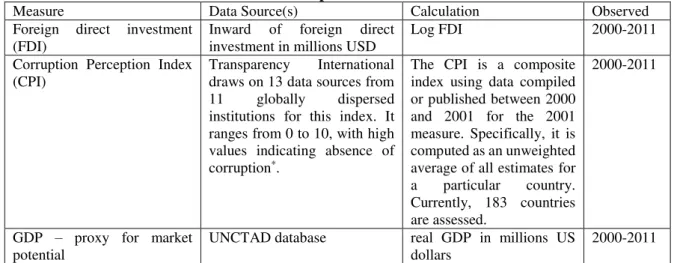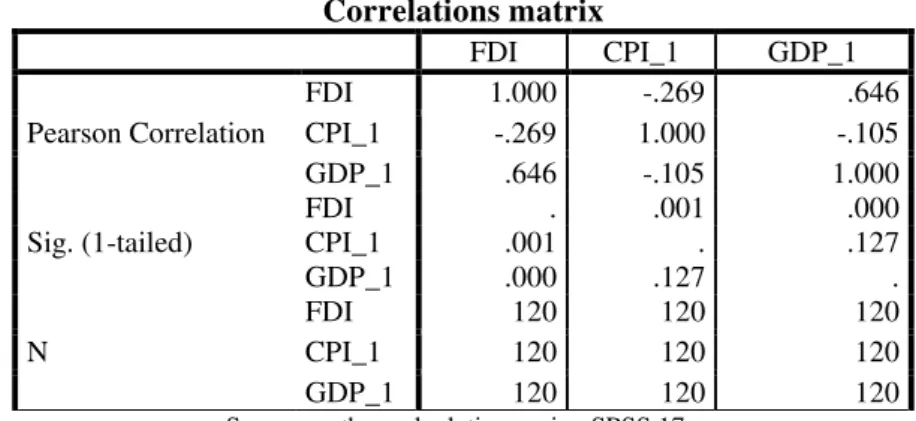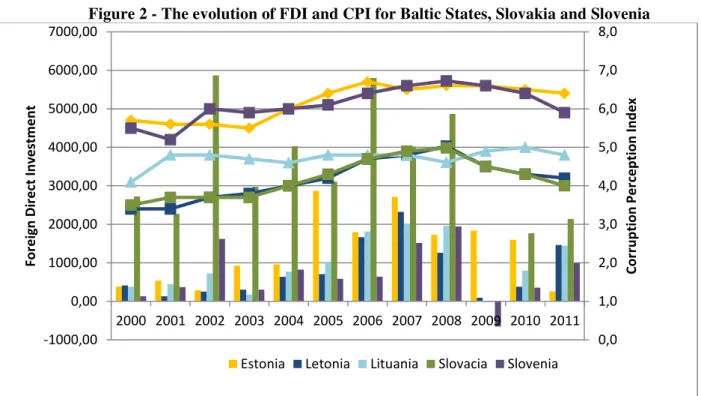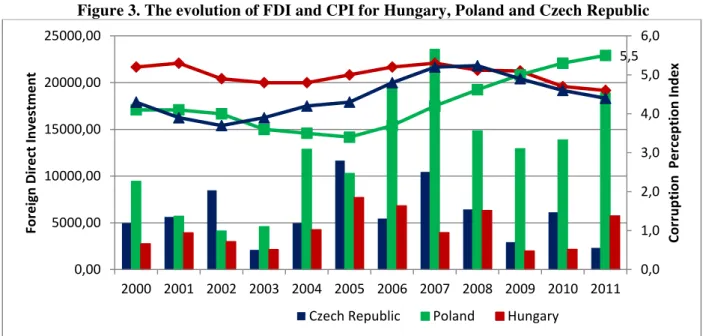CORRUPTION AND FOREIGN DIRECT INVESTMENT.
EVIDENCE FROM CENTRAL AND EASTERN EUROPEAN
STATES
Cristina Mihaela Amarandei*
Abstract: This paper examines the impact of corruption on foreign direct investment inflows for ten Central and Eastern European states. The paper attempts to answer the question: what is the role of corruption in attracting foreign direct investments? Using the data from UNCTAD for foreign direct investment and Corruption Perception Index from Transparency International, for a period of 12 years, 2000-2012, we evaluate the specific impact of corruptions on FDI using GDP as control variable. Our results confirm the majority of literature and show a negative significant relation between the variables analyzed, but at a lower intensity than expected.
Keywords: foreign direct investment; institutions; corruption. JEL Classification: D73; E02; F21.
INTRODUCTION
Taking into consideration the CEE states, after the 1989 moment, foreign direct investment was
seen as the best solution for national economic development. As Dunning (1993, p. 20), for example, has argued that multinational companies „are uniquely able to supply many of the necessary ingredients for economic growth, a reshaping of attitudes to work and wealth creation, the redesigning
of the business and legal framework, especially with respect to property rights and contractual relationship”.
Institutions have an essential role in setting the „rules of game” by which individuals interact in a market economy (North, 1990), especially by ensuring the competiveness of markets.
After the 1989 events, the countries from Eastern Europe looked at foreign examples in building
its institutions and reforming their economies. Still, new institutions were created without taking into
to consideration that the distinct cultural and systematic inheritance influences especially informal
institutions such as norm and values. In many countries weak legal framework permitted a large extent
of opportunistic behavior, bribery and corruption (Nelson et al., 1998).
Looking at the literature that examines in which extent the quality of institutions plays an
important role in the development of an economy we found conflicting results. In general, many
studies demonstrated that bad governance fosters corruption and can lead to inefficient allocation of
resources and impede economic progress. Many authors, such as Gyimah-Brempong (2002), Mo
(2001), Li et al. (2000) and Mauro (1995) had found that corruption has significant adverse effects
on economic growth.
Corruption can also create obstacles to doing business, according to World Bank (2002), deter
foreign direct investment flows (Wei, 2000), cause misallocations of public expenditures (Mauro,
1997; Tanzi and Davoodi, 1997) or reduce rates of investment.
There are many ways in which corruption can impact on economic behaviour and impose
economic losses on society: it can damage incentives and destroy opportunities; it can distort price
signals and deplete resources; and it can create uncertainty and compromise public policy.
Our study presents the effect of corruption and market potential on foreign direct investment
for 10 Eastern European countries for a period of 12 years. The results show that the level of
corruption deters foreign investment inflows.
The research has the following structure. Section 1 presents the theoretical approach on foreign
direct investment, corruptions and a short literature review of econometric studies on the subject.
Methodological aspects and results are presented in Section 2 and conclusions in Section 3.
1. THEORETICAL APPROACH ON FOREIGN DIRECT INVESTMENT,
CORRUPTION
1.1. Determinants of FDI
The process of economic globalization appears in the form of international trade in goods in
services, short-term capital movements among countries and a rapid increase in foreign direct
investment (FDI). FDI refer to long term cross-border investment with a substantial influence both
on receiving country and on the investing multinational company.
Two main types of determinant factors: the gravity factors and the policy related factors are
suggested by the empirical literature regarding the determinants of FDI. The gravity factors refer to
issues such as market size and the proximity of the host country to the source country and have been
stability, trade policies (trade costs, openness degree), fiscal policies (average taxation rate or the
fiscal burden, tax incentive), labour policies (labour costs and skills), the degree of regional
integration, infrastructure and institutions.
Concerning the magnitude and sign of FDI determinants for Central and Eastern European
States, many of the studies show ambiguous results when analyzed the mode of entry, the type of FDI
or the target industry.
Regarding to the relation between determinants of FDI, the table below summarize some
empirical studies:
Table 1 - Determinants of foreign direct investment
Variables
Sign of the relation
Positive Negative Insignificant
GDP/capita
Schneider and Frey (1985)
Birsan and Buiga (2009)
Jaspersen et al. (2000) Wei (2000)
Hausmann and Fernandez-Arias (2000)
Political risk
Schneider and Frey (1985) Edwards (1990)
Gastanaga et al. (1998) Moosa and Cardak (2006)
Loree and Guisinger (1995) Jaspersen et al. (2000)
Hausmann and Fernandez-Arias (2000)
Corruption Eagger and Winner (2005) Wei (2000) Akcay (2001)
Source: author representation based on the studies presented.
The available empirical findings based on EU countries make it difficult to draw general
conclusions about the source of heterogeneity in the determinants of FDI for Central and Eastern
European countries.
1.2. FDI and corruption
It is a large debate surrounding the definition of corruption, many authors expressing different approaches on the subject. The narrowest approach specifies that corruption is „the use of public office for private gain”.
The abuse of not only the public office but also the private or commercial takes part of the broad
Theoretically, we must distinguish between „grabbing hand” and „helping hand” influences of corruption on inward FDI.
In the short run, corruption raises the cost of a firm’s foreign investment, since (i) firms have to pay bribes (similar to taxes), (ii) they are engaged in resource-wasting rent seeking activities
(Applebaum and Katz, 1987; Murphy et al., 1991; Shleifer and Vishny, 1993), and (iii) they have to
bear additional contract-related risks, because corruption contracts are not enforceable in courts
(Boycko et al., 1995). Corruption in the host country thus acts as a grabbing hand, reducing the profits of firms and therefore lowering a firm’s incentives to invest abroad.
Further, corruption reduces the productivity of public inputs (infrastructure) which, in turn, decreases a country’s locational attractiveness (Bardhan, 1997; Rose-Ackermann, 1999; Lambsdorff, 2003). On the other hand, multinational firms might be willing to accept paying bribes in order (i) to
speed up the bureaucratic processes to obtain the legal permissions for setting up a foreign plant (Lui,
1985), and (ii) to gain access to publicly funded projects (Tanzi and Davoodi, 2000). In this case,
corruption acts as a helping hand, increasing profits of multinational firms. If the revenue effects
outweigh the cost effects, corruption is expected to increase FDI. In the presence of pre-existing
government and/or bureaucratic failures, however, corruption may be efficiency-enhancing (Bardhan,
1997; Aidt, 2003). Corruption then may also be rent-creating, with the rents from controls over
foreign investment shared by corrupt officials and foreign investors. Glass and Wu (2002) focus on
the impact of corruption on FDI in a general equilibrium model with Northern innovation and
Southern imitation (Grossman and Helpman, 1991).
Multinational firms are vertically organized and shift their production to the low cost country.
The firms bear the risk of illegal imitation of their innovations, and of the requirement to pay bribes
to public officials. Analyzing four types of bribes (bribes on sales or profits as well as repeated and
one-time bribes in order to obtain a permission to sell in the foreign market), Glass and Wu (2002)
demonstrate that the general equilibrium effects of corruption on FDI are in principle ambiguous, and conclude (Glass and Wu, 2002, p. 19) that „corruption need not be bad for FDI..., but rather corruption may foster inward FDI”.
2. ECONOMETRIC ANALYSIS
Our model is based on theoretical approach found in academic literature. In order to isolate the
��,� = + ���,�− + ��,�− + ��,�,
where � is the country subscript, � is the time subscript, ��are unknown parameters to be
estimated, ��,�is the usual random disturbance term. All independent variables are lagged one year in
order to avoid simultaneity with the dependent variable and taking into account that decisions to
invest abroad take time.
2.1. Data variables
FDI inflows are drawn from UNCTAD database for 10 countries form Central and Eastern
Europe: Bulgaria, Czech Republic, Estonia, Hungary, Latvia, Lithuania, Poland, Romania, Slovakia
and Slovenia.
In the examination of corruption the most used measure is the Corruptions Perceptions Index
(CPI) reported annually by Transparency International. This non-governmental organization studies
corruption since 1995 looking to draw attention on the damage caused by corruption and to stimulate
governments to adopt and implement anti-corruption regulations. The CPI ranges from zero (totally
corrupt) to ten (absence of corruption). The index is based on surveys filled by specialists and
calculated annually for a wide range of countries.
We also use as control variable the real GDP for the countries analyzed.
The table below shows the variables used in our analysis.
Table 2 - Description of the variables
Measure Data Source(s) Calculation Observed
Foreign direct investment (FDI)
Inward of foreign direct investment in millions USD
Log FDI 2000-2011
Corruption Perception Index (CPI)
Transparency International draws on 13 data sources from 11 globally dispersed institutions for this index. It ranges from 0 to 10, with high values indicating absence of corruption*.
The CPI is a composite index using data compiled or published between 2000 and 2001 for the 2001 measure. Specifically, it is computed as an unweighted average of all estimates for a particular country. Currently, 183 countries are assessed.
2000-2011
GDP – proxy for market potential
UNCTAD database real GDP in millions US dollars
2000-2011
2.2. Results and interpretation
Our analysis uses the multivariate regression technique.
The results show that, according to the Correlations table, between foreign direct investment
and the perceived corruption is a negative significant relation, respectively a rise in the perception of
corruption for the countries analyzed deter the expected inflows of FDI for the next years.
Also it can be noticed a moderate direct relation between market potential and foreign direct
investment received by the Central and Eastern European countries.
This founding can be explained by the inclusion in the sample analyzed of the Baltic states who
have a small GDP compared with the rest of the sample and high levels of foreign direct investment.
Correlations matrix
FDI CPI_1 GDP_1
Pearson Correlation
FDI 1.000 -.269 .646 CPI_1 -.269 1.000 -.105 GDP_1 .646 -.105 1.000
Sig. (1-tailed)
FDI . .001 .000
CPI_1 .001 . .127
GDP_1 .000 .127 .
N
FDI 120 120 120
CPI_1 120 120 120
GDP_1 120 120 120
Source: author calculations using SPSS 17.
Table bellow shows that the model chosen for our analysis is significant (.Sig<.005) and
adequate.
Still, the Model Summary table shows that our model could be improved in order to have better
values of R and R square by adding other institutional variables in equation beside corruption like
Model Summary Model R R
Square
Adjusted R Square
Std. Error of the Estimate Change Statistics R Square Change F Change
df1 df2 Sig. F Change 1 .677a .458 .449 3327.20174 .458 49.428 2 117 .000
a. Predictors: (Constant), GDP_1, CPI_1
Source: author calculations using SPSS 17.
The qualitative assessment of the impact of corruption on FDI for the countries analyzed
confirms the results of empirical analysis.
First of all, the figure 1 shows that Romania and Bulgaria are considered highly corrupted
countries. The evolution of the perceived corruption improved over time only for Romania, while
Bulgaria marked a decrease of the CPI Index. Regarding to FDI inflows attracted by Romania and
Bulgaria we can observe that are correlated with the evolution of CPI index. The decrease of the
measure of corruption (meaning a rise in the perceived corruption (0-highly corrupted to 10 – very
clean)), correspond with lower values of FDI inflows in the next year.
Figure 1 - The evolution of FDI and CPI for Romania and Bulgaria
Source: UNCTAD and Transparency International.
Baltic States, Slovakia and Slovenia show the same evolution as Romania and Bulgaria (see
figure 2). Still, we must mention that Lithuania, Slovakia and Latvia are perceived as more corrupted
countries than Slovenia and Estonia. We must mention that the most free of corruption country of
ECEC is Estonia with a CPI score higher than 6.0.
0,0 0,5 1,0 1,5 2,0 2,5 3,0 3,5 4,0 4,5 0,00 2000,00 4000,00 6000,00 8000,00 10000,00 12000,00 14000,00 16000,00
2000 2001 2002 2003 2004 2005 2006 2007 2008 2009 2010 2011
The highest level of FDI inflows are attracted by Slovakia even if the CPI index shows the
lowest levels for the countries analyzed. These results can be explained by the active policy promoted
by the Slovak government for attracting foreign direct investors (mainly fiscal incentives).
Figure 2 - The evolution of FDI and CPI for Baltic States, Slovakia and Slovenia
Source: UNCTAD and Transparency International.
Analyzing Poland, Hungary and Czech Republic we can observe a mainly indirect relation
between foreign direct investments and CPI. Czech Republic and Hungary have a particularly trend
of the perceived corruption showing the same evolution. After a period of reforms and concrete efforts
in reducing corruption, the emergence of the economic crises in 2008 marked decreases in the levels
of corruption perception index and in FDI inflows.
Poland stands alone in the group (see figure 3). We can see that even if the effect of the
economic crises reflects in the levels of FDI inflows, the perceived corruption is constantly improving
from 2005 to 2011.
0,0 1,0 2,0 3,0 4,0 5,0 6,0 7,0 8,0
-1000,00 0,00 1000,00 2000,00 3000,00 4000,00 5000,00 6000,00 7000,00
2000 2001 2002 2003 2004 2005 2006 2007 2008 2009 2010 2011
Co
rr
u
p
tion
Per
ce
p
tion
In
d
e
x
Fo
re
ig
n
Di
re
ct
In
v
e
stm
e
n
t
Figure 3. The evolution of FDI and CPI for Hungary, Poland and Czech Republic
Source: UNCTAD and Transparency International.
CONCLUSIONS
FDI receiving host countries expect foreign investments to support economic growth,
competitiveness, employment and technological progress. For Central and Eastern European states it
was also an expectation regarding the transition process and improve efficiency. But the transition
from centralized economy to market orientated states showed many challenges handled by each
country analyzed in her way. One of these challenges proved to be the emergence of systematic
corruption.
Our analysis focuses on the impact of corruption on foreign direct investment flows attracted
by ECE countries. Using as determinants the CPI index and GDP, our results show a negative
significant relation between corruption and FDI and a mild positive significant relation between GDP
and FDI. These results can be explained by the fact that the foreign direct investors decide to invest
or not after a complex analysis of the business environment. So, we can affirm that for Central and
Eastern European states the impact of market potential, although high, is diminished by the other
factors related with stability and predictability of the regulatory system. Regarding the perceived
corruption, our analysis show that are impetuous necessary reforms of public administration in order
to reduce all the forms of corruption and bribery. Again, Romania, a highly corrupted country after
Transparency International methodology, needs coherent reforms in reducing corruption and in the
same time increase the country locational attractiveness for foreign direct investors.
5,5 0,0 1,0 2,0 3,0 4,0 5,0 6,0 0,00 5000,00 10000,00 15000,00 20000,00 25000,00
2000 2001 2002 2003 2004 2005 2006 2007 2008 2009 2010 2011
Co rr u p tion Pe rc e p tion In d e x Fo re ig n Di re ct In v e stm e n t
ACKNOWLEDGEMENTS
This work was supported by the European Social Fund in Romania, under the responsibility of
the Managing Authority for the Sectoral Operational Programme for Human Resources Development
2007-2013 [grant POSDRU/CPP 107/DMI 1.5/S/78342].
REFERENCES
Aidt, T. S. (2003) Economic Analysis of Corruption: A Survey, The Economic Journal, Vol. 113,
Issue 491, pp. 632–652.
Akçay, S. (2001) Is Corruption an Obstacle for Foreign Investors in Developing Countries? A Cross-Country Evidence, Yapi Kredi Economic Review, vol.12, no.2, pp. 27–34.
Appelbaum, E., Katz, E. (1987) Seeking Rents by Setting Rents: The Political Economy of Rent
Seeking, Economic Journal, Royal Economic Society, Vol. 97, Issue 387, pp. 685-699.
Bardhan, P. (1997) Corruption and Development: A Review of Issues, Journal of Economic Literature,
vol. XXXV (September), pp. 1320-1346.
Bevan, A., A., Estrin, S. (2000) The determinants of FDI in transition economies, Discussion Paper
No.2638, Center for Economic Policy Research, London.
Birsan, M., Buiga, A. (2009) FDI determinants: Case of Romania, Transition Studies Review, vol.
15, issue 4, pp. 726-736.
Boycko, M., Shleifer, A., Vishny, R. (1995) Mass privatisation in Russia, in: OECD, Mass
privatization: An initial assessment, OECD, Paris.
Dunning, J. H. (1993) Multinational enterprises and the global economy, Addision-Wesley,
Wokingham.
Egger, P., Winner H. (2005) Evidence on corruption as an incentive for foreign direct investment,
European Journal of Political Economy, vol. 21, issue 4, December 2005, pp. 932-952.
Gastanaga, V., Nugent, J., Pashamiova, B. (1998) Host Country Reforms and FDI Inflows: How Much
Difference Do They Make?, World Development, vol.26, no.7, pp. 1299-1314.
Glass, A. J., Wu, X. (2002) Does Corruption Discourage Foreign Direct Investment and Innovation?,
Grossman G., Helpman E. (1991) Innovation and Growth in the Global Economy, Cambridge: MIT
Press.
Gyimah-Brempong, K. (2002) Corruption, Economic Growth and Income Inequality in Africa,
Economics of Governance, vol.3, issue 3, pp. 183-209.
Hausmann, R., Fernández-Arias, E. (2000) Foreign Direct Investment: Good Cholesterol?,
Inter-American Development Bank,Working Paper No. 417, Washington.
Jaspersen, S., Aylward, A., Knox, A. (2000) The Effects of Risks on Private Investment: Africa
Compared with Other Developing Areas in P. Collier and C. Pattillo (eds.) Investments and
Risks in Africa, Saint Patrick Press, New York, pp. 71-95.
Lambsdorff, J. G. (2003) How Corruption Affects Productivity, Kyklos, vol. 56, issue 4, pp. 457–474.
Li, H., Xu, C., Zou, H.-F. (2000) Corruption, Income Distribution, and Growth, Economics and
Politics, vol.12, issue 2, pp. 155-182.
Loree D. W., Guisinger S. (1995) Policy and Non-policy Determinants of U.S. equity Foreign Direct
Investment, Journal of International Business Studies, vol.26, issue 2, pp. 281-299.
Lui, F.T. (1985) An equilibrium queuing model of bribery, Journal of Political Economy, vol. 93,
issue 4, pp. 760–781.
Mauro, P. (1995) Corruption and Growth, Quarterly Journal of Economics, vol.110, issue 3, pp.
681-712.
Mauro, P. (1997) The Effects of Corruption on Growth, Investment, and Government Expenditure: A
Cross Country Analysis in Kimberly Ann Elliott (ed.) Corruption and the Global Economy,
Institute for International Economics.
Mo, H. (2001) Corruption and Economic Growth, Journal of Comparative Economics, vol.29, issue
1, pp. 66-79.
Moosa, I. A., Cardak, B. (2006) The Determinants of Foreign Direct Investment: An Extreme Bounds
Analysis, Journal of Multinational Financial Management, vol.16, issue 2, pp. 199–211.
Murphy, K., Shleifer, A., Vishny, R. (1993) Why Is Rent-Seeking So Costly to Growth?, American
Economic Review, Papers and Proceedings, vol. 83, no. 2.
Nelson, J. M., Tilley, C., Walker, L. (1998) Transforming post-communist political economies: Task
force on economies in transition, National Research Council, National Academy Press,
North, D. (1990) Institutions, Institutional Change and Economic Performance, Cambridge:
Rose-Ackerman, S. (1999) Corruption and government: Causes, consequences, and reform,
Cambridge University Press.
Schneider, F., Frey, B.S. (1985) Economic and political determinants of foreign direct investments,
World development, vol.13, no. 2, pp. 161-175.
Shleifer, A., Vishny, R. (1993) Corruption, Quarterly Journal of Economics, vol.108, no.3,
pp.599-617.
Tanzi, V., Davoodi, H. (1997) Corruption, Public Investment, and Growth, IMF Working Paper,
97/139.
Tanzi, V., Davoodi, H. (2000) Corruption, Growth, and Public Finances, IMF Working Paper No.
00/182.
Wei, S.-J. (2000a) How Taxing is Corruption on International Investors, Review of Economics and
Statistics, vol.82, no.1, pp. 1-11.
***Transparency International Reports, Corruption Perception Index for 2000-2011 available at
http://www.transparency.org/research/cpi/overview, accessed on July 2013.
***UNCTADStat, available at http://unctadstat.unctad.org/ReportFolders/reportFolders





